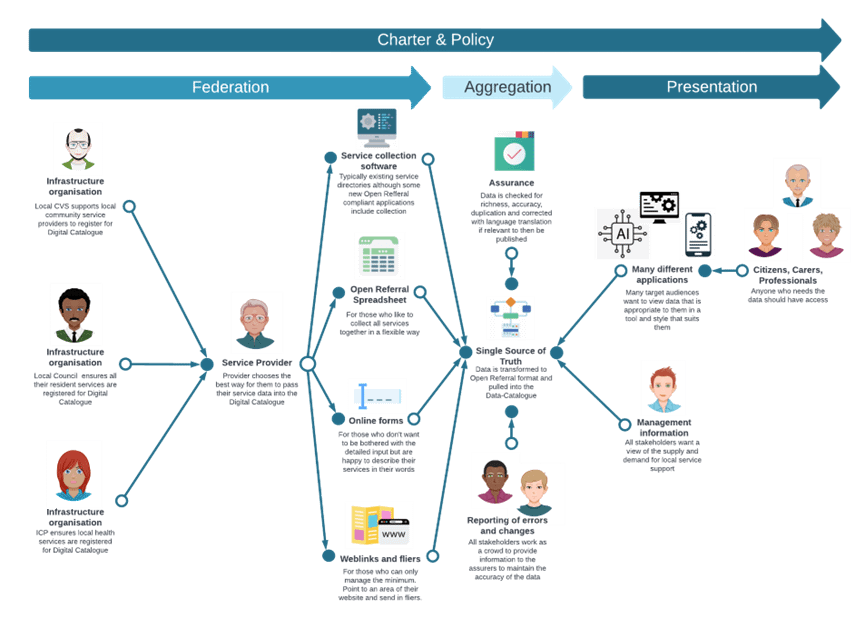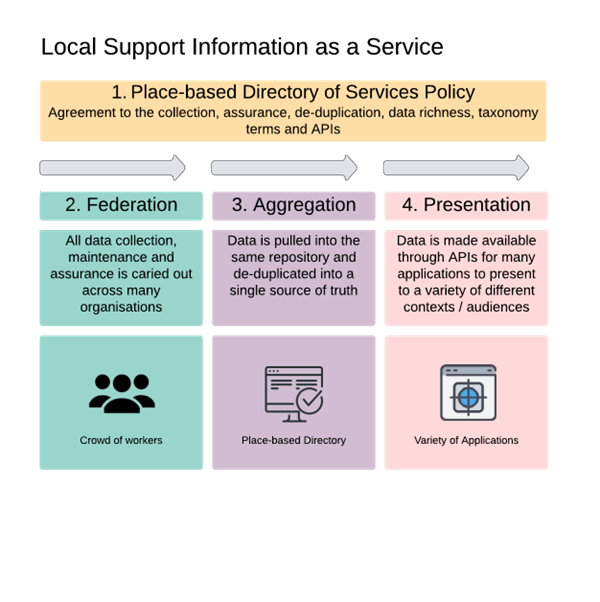Turning Self-Care into a Reality
Introduction
It is estimated that over 70% of all referrals nationally for health and care services do not meet the threshold for statutory support. Patients / service referrers are expected to self-support / self-serve by accessing ‘Information, Advice and Guidance’ (IAG) services and by attending local third sector support groups / activities.
Providing accurate information about local support is therefore one of the most important fundamental requirements across health and social care delivery. However, the current approaches and models across Health and Care partnerships to, for maintaining accurate information for both frontline workers and patients / service users tend to be
· under-resourced,
· not digital in their design (relying on analogue data records),
· lack clear responsibility and leadership to ensure success,
· fail to meet accessibility standards, and
· are delivered in hundreds of stand-alone silos within any local care and health partnership.
The end result is that frontline workers and citizens invest significant time navigating / searching for local groups and the right advice or guidance; the result is that they can be referred to services that do not exist or that simply refer them on to another service that might refer them on to something else again. Citizens are left confused and frustrated and more often than not, just give up; prevention remains an undelivered ambition and demand continues to overwhelm the system.
Digital CoProduction have worked on over a dozen national, local and international projects; and worked with a number of the leading technology and consultancy suppliers in the field. Through these experiences, this resulting white paper introduces a vision to transform the delivery of ‘Local Support Information as a Service’ (LSIaaS). The focus for the white paper is on a model and ways of working between partners to maintain and re-use a single set of information about all support locally. The document demonstrates how a more joined-up model will
· Reduce the costs of delivering Local Support Information As A Service (including IAG services)
· Deliver more accurate sets of information and advice (at that reduced cost)
· Will increase the number of people that are successfully referred into and access the right service at the right time – delivering real prevention
· Improve experiences for both citizens and frontline workers
· Deliver a more efficient model for frontline workers.
Implementation is not an overnight fix. However, it is at the heart of digital transformation, and will ensure that the local care and health partnership can truly make every contact count (both face-to-face and online) and maximise the prevention impact of these interactions.
We need to move to a Place-Based approach?
The current models in most “places” are very silo-based in their approach. Each stand-alone service area or organisation looks to maintain their own list of local services, support and advice and guidance. The research indicates that across health, third sector and local authority partners there will be more than 200 lists being maintained in an average sized Metropolitan Borough geography (and more like 600 in a large County Council footprint).
The proposed place-based approach is a many-to-many model, where service information can be entered into a number of “back-end” tools or systems, can be aggregated into one “information asset” and then viewed through a very broad range of “frontline” tools.
Critical to the success of the model is the adoption of a data standard to enable this inter-operability. Commitment to the adoption of data standards generally is Central and Local Government strategy and policy. Over 200 Local Authorities nationally for example signed up to the 2018 Digital Declaration that has adoption of data standards as a fundamental building block for transformation. The Open Referral data standard (technically named Human Services Data Standard[1]) has been endorsed by Cabinet Office, DLUHC and DCMS as the approved standard and adopted by DSA[2] for the definition of Local Services.
Introducing the Model
The proposed framework which is illustrated over the page, consists of three elements
· A Charter – which is a short document for partners locally to sign up to a shared ambition and identifies the headline principles and benefits that partners would be endorsing. All partners will be at different stages in their digital journey, but a charter demonstrates that shared intent and can mobilise the project going forward
· The Policy – setting out the detail of the principles and the technical considerations. This covers considerations about sharing costs, the approach to joint working for a shared assurance function, ongoing governance / decision-making, (including the approach to approvals for sharing of this specific set of data), the definition in detail of the data standard and the taxonomies that will be used. The policy also details the actual processes that are identified within the headline model.
· The Model – which consists of the following key steps and processes
o Federating data collection – so that agencies have a shared set of processes for submitting information and carrying out any safeguarding with regards to which organisations are allowed to promote their service offers
o Aggregating the information – including steps to de-duplicate and assure the information, as well as ensuring that information is made available in multiple languages, before it is made available for re-use
o Publishing the information – which relates to how information is made available for re-use in other tools. This includes processes for capturing and making management information available about high volume searches, poor feedback from users etc.
Next Steps
Adopting data standards is Government policy, both nationally and locally. It forms part of the strategy for every Integrated Care System and every Integrated Care Partnership. It is not necessarily something that can be implemented quickly, but it is the inevitable direction of travel and sits at the heart of true digital transformation.
Digital CoProduction are making their white paper available to anyone who is interested but the theory needs exploring on the ground and so we welcome further opportunities to implement the model in Council or Integrated Care Systems.
We are also developing a maturity framework that provides insight into the next steps for any local area looking to improve how they manage information (both advice and guidance and information that captures and describes local support). This is about getting control of how information is managed and published locally – the right guidance and advice at the right time is the key to making prevention a reality. Without that focus, citizens will continue to be frustrated by their experiences in looking to access prevention advice and support; they will continue to by-pass or give-up on the prevention step and continue to overwhelm statutory urgent and emergency support across both health and care processes.
Digital CoProduction is focused on tackling Local Support Information as a Service. We’d be delighted to welcome you on the journey with us – simply request a chat and we will send you the charter & policy and the white paper- hello@digitalcoproduction.co.uk
[1] https://openreferral.org/faqs/what-is-the-human-service-data-specification-hsds
[2] https://www.gov.uk/government/publications/open-standards-for-government/record-and-share-informatio...



